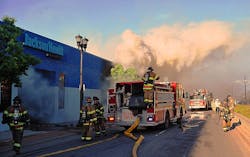IAFC Issues Response Guidelines for Potential Unrest Around Elections
The International Association of Fire Chiefs (IAFC) issued a safety notice to its members about potential unrest around next week's elections.
"As Election Day approaches, the potential for unrest and other election-related problems exist," the notice states. "It is important that our nation’s first responders stay focused on the mission of serving our communities and public safety partners and resist any inclination to be drawn into emotionally heated debates in the workplace. We must remain unified."
The IAFC has been working with national law enforcement and homeland security agencies to monitor possible threats that involve crowds at voting sites, large-scale gatherings and public events.
Several threats possible
According to the IAFC, law enforcement and intelligence agencies shared the following list of threats that could be carried out in the coming weeks that could put firefighters in harm's way:
- Arson
- Cyber Attacks
- Chemical or Biological Agent Dispersal, and White Powder Mailings
- Shooting incidents
- Terrorism
- Vehicle rammings
- Unrest
The notice suggests fire departments collaborate with other public safety departments to optimize responder safety and situational awarness. The use of Hot, Warm and Cold Zones can be established to determine threat levels to responders during unrest.
Establishing Rescue Task Forces - a combined response of law enforcement, fire and EMS resources in a single group - is suggested to create a cohesive response for suppression and medical incidents, along with security elements.
Response guidelines
The IAFC presented a detailed response guideline in their notice, which are outlined below to get fire departments prepared.
- Maintain situational awareness
- Ensure that COVID-19 mitigation guidelines are being followed at all incident locations, including the Incident Command Post (ICP), Staging Areas, and Treatment Areas
- Provide unified messaging and consider developing a Crisis Communications Plan
- Unified Command is the recommended framework for developing comprehensive incident objectives and strategies
- A Safety Officer should be assigned to review the IAP for safety implications, develop a Medical Plan, monitor social distancing and PPE practices, present safety messages, and suggest adjustments as needed to prevent unsafe acts
- Provide for personnel relief and rehabilitation
- Identify unsafe areas during mass gatherings and incidents involving large crowds
- Consider needed adjustments to Rescue Task Force (RTF) operations.
- Ensure that emergency/gross decontamination provisions for first responders and civilians are in place that harmonize with the guidance of departmental and public health authorities
Additional Resources

